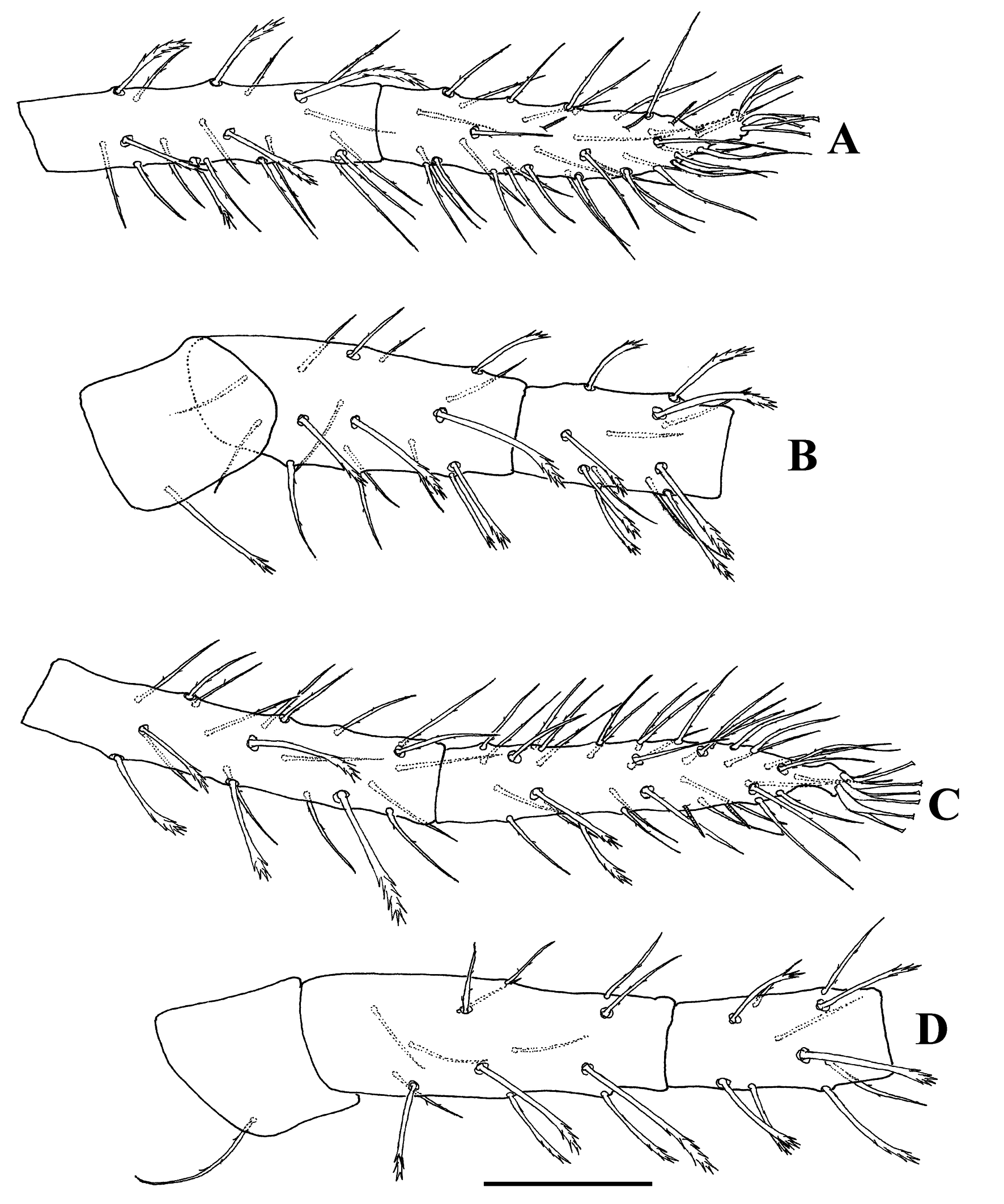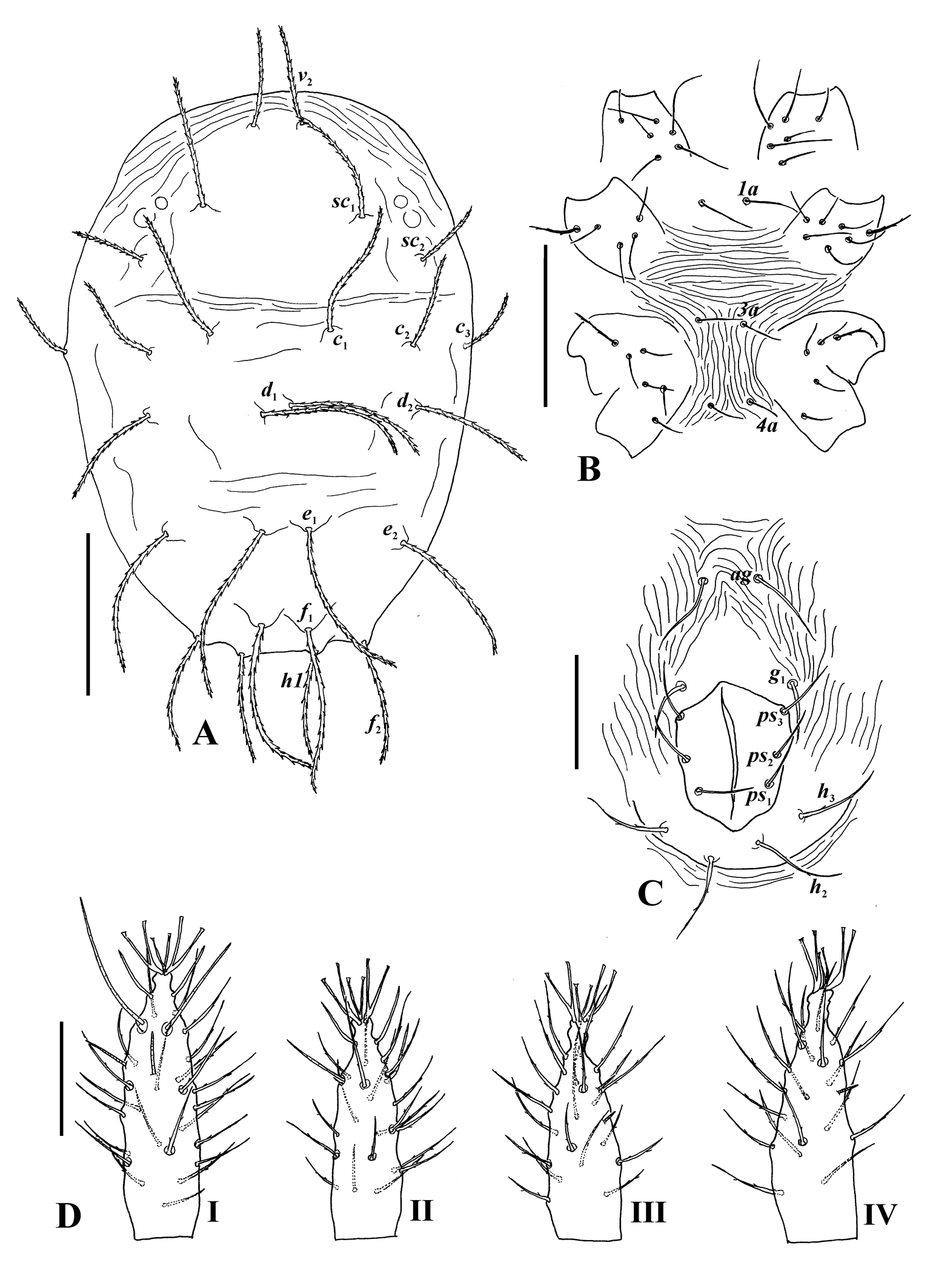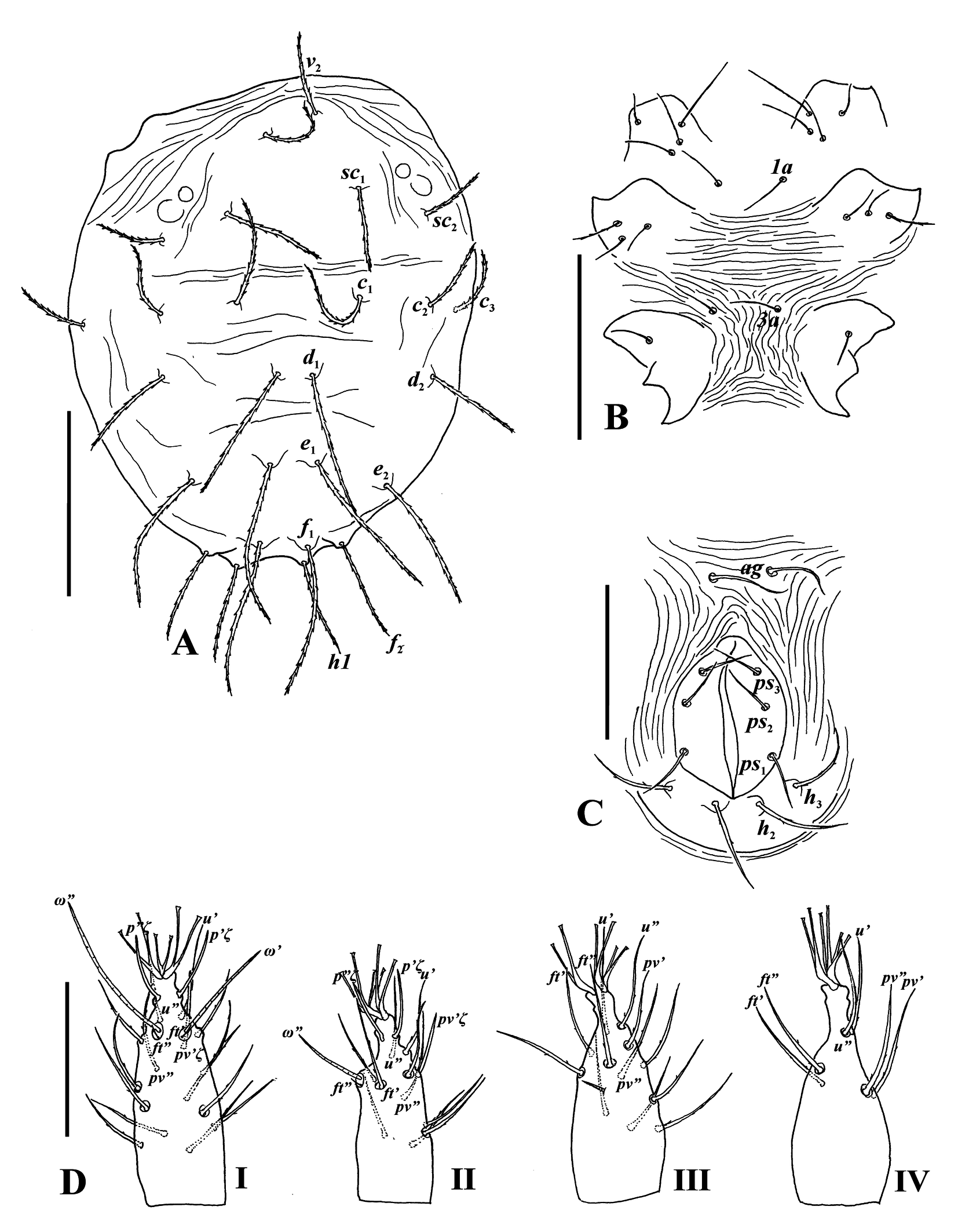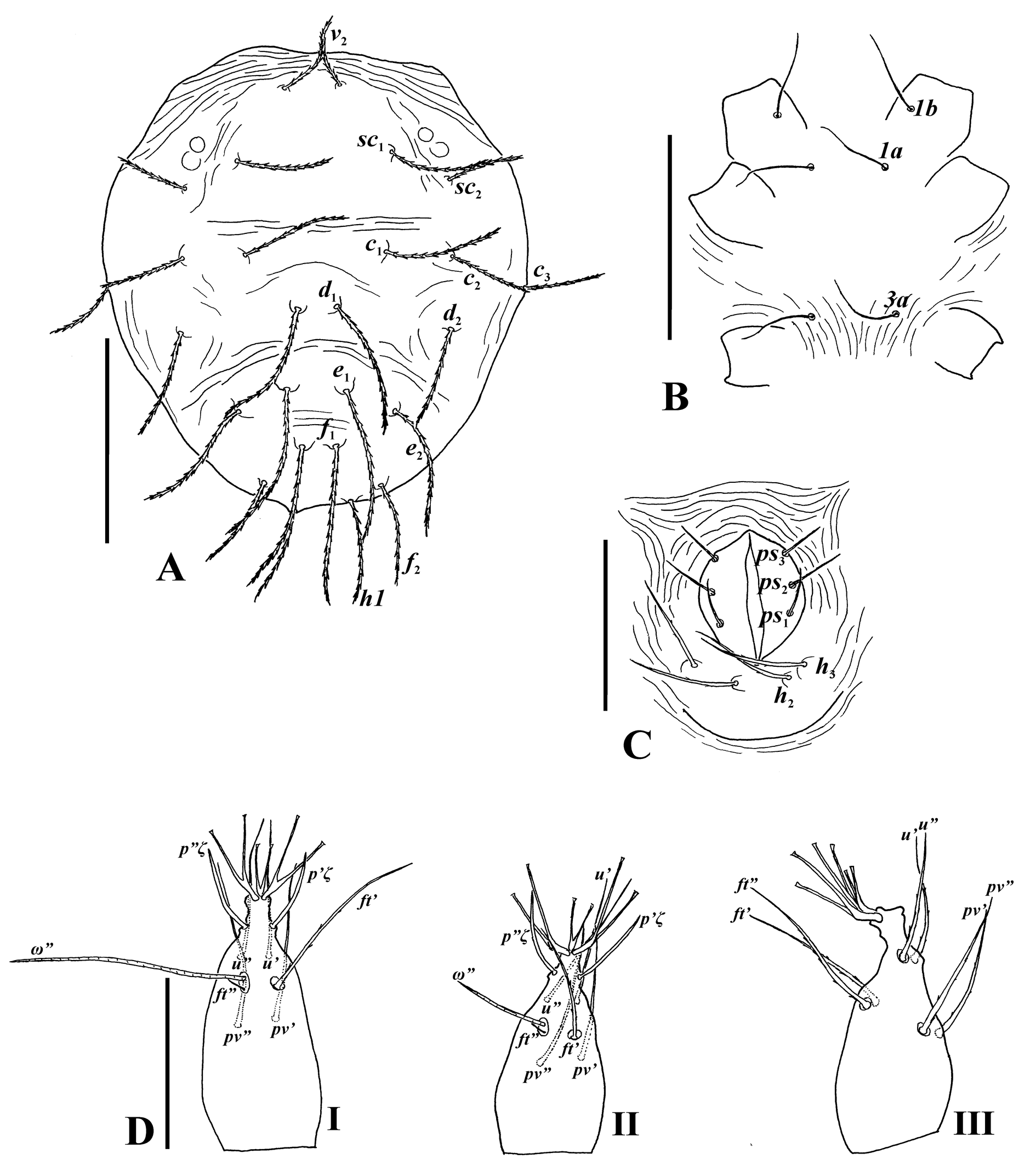Rediscovery of the neotrichous species Tauriobia insueta Livshitz & Mitrofanov (Acari: Trombidiformes: Tetranychidae)
Stathakis, Theodoros I.  1
; Tsaklidou, Yelena
1
; Tsaklidou, Yelena  2
and Panou, Eleni N.
2
and Panou, Eleni N.  3
3
1✉ Laboratory of Agricultural Zoology and Entomology, Department of Crop Science, Agricultural University of Athens, 75 Iera Odos str., 11855, Athens, Greece.
2Laboratory of Agricultural Zoology and Entomology, Department of Crop Science, Agricultural University of Athens, 75 Iera Odos str., 11855, Athens, Greece.
3Laboratory of Agricultural Zoology and Entomology, Department of Crop Science, Agricultural University of Athens, 75 Iera Odos str., 11855, Athens, Greece.
2024 - Volume: 64 Issue: 4 pages: 1126-1137
https://doi.org/10.24349/ogg4-hzajZooBank LSID: 8E53DF75-D320-4140-8ADE-4782F6CE329A
Original research
Keywords
Abstract
Introduction
The monotypic genus Tauriobia (Trombidiformes: Tetranychidae) was erected by Livshitz and Mitrofanov (1967) based on Tauriobia insueta, a species collected form Cistus creticus L. (Cistaceae) in Ukraine. It belongs to the tribe Hystrichonychini Pritchard & Baker, and it is characterized by unusually increased number of coxal setae, the presence of additional setae in the coxisternal area between 3a and 4a, and enriched chaetotaxy on other leg segments. Coxal and ventral hypertrichy in Tauriobia is a plethotrichous type of neotrichy which is also present in the genus Neotrichobia Tuttle & Baker (He et al. 2023). Aplonobia (Brachynychus) Mitrofanov & Strunkova also has coxal neotrichy (oligotrichous type) and the only case of dorsal neotrichy within the family Tetranychidae appears in the genus Dasyobia Strunkova (Lindquist 1985; Mahdavi et al. 2024).
Tauriobia insueta is known only from Ukraine (Migeon and Dorkeld 2024). It is reported for the second time in the world. The species is redescribed based on Greek material collected from the same host plant species. All immature stages are described for the first time. The ontogenetic development of leg and idiosomal chaetotaxy are discussed. Additionally, a key to genera and subgenera of the tribe Hystrichonychini Pritchard & Baker is provided.
Material and methods
Plant samples were collected during a survey (2017–2018) for the mite fauna of phrygana vegetation of the Greek mountain Parnis, Co. Attica. Mites were extracted using Berlese-Tullgren funnels and stored in 70% ethanol. Permanent mounts were made using Hoyer's medium.
Drawings were made in pencil using a drawing tube (camera lucida) attached to a Zeiss Axioskop 2 microscope and inked with Rotring rapidograph pens. For preparation of the digital illustrations CorelDRAW X8 was used. Photos were taken with an Euromex Camera model CMEX 5.0 adapted to the microscope. Measurements were made from slide mounted specimens using stage calibrated ocular micrometers. Body length was measured from the anterior margin of idiosoma to its posterior one, and the width at its broadest part. Setae were measured from the center of the alveoli to their tips; distances between setae were measured as the distance from the center of one setal base to the other. Legs were measured from the base of trochanter to the base of ambulacrum. Leg setal counts are given in the order: coxa-trochanter-femur-genu-tibia-tarsus. Numbers of setae refer to tactile setae, solenidia are given in parentheses and alternative counts are given in brackets. All measurements are given in micrometers (μm).
For the descriptions, the palp, leg and idiosomal chaetotaxy follow that of Lindquist (1985).
All specimens are deposited in LAZAU (The Acari collection of Laboratory of Agricultural Zoology and Entomology, Agricultural University of Athens, Greece).
Taxonomy
Family Tetranychidae Donnadieu, 1875
Subfamily Bryobiinae Berlese, 1913
Tribe Hystrichonychini Pritchard & Baker, 1955
Genus Tauriobia Livshitz & Mitrofanov, 1967
Tauriobia Livshitz & Mitrofanov, 1967: 1850. Type-species: Tauriobia insueta Livshitz & Mitrofanov, 1967
Diagnosis (female)
True claws and empodia padlike with two rows of tenent hairs; 2 pairs of duplex setae on tarsus I, 1 pair on tarsus II; propodosoma with 3 pairs of setae (v2, sc1, sc2), prodorsal lobes absent, opisthosoma with 10 pairs of setae (c1–3, d1–2, e1–2, f1–2, h1); sacral setae f1 in normal position; peritreme developed in a distal oval anastomosis; dorsal body setae set on tubercles, long, tapering, serrate and acute distally; one pair of aggenital (ag1) setae, 2 pairs of genital setae (g1–2), 3 pairs of pseudanal setae (ps1–3) and 2 pairs of ventrocaudals (h2–3) present ventrally; coxal and ventral hypertrichy; all tarsi with solenidia; tectal setae (tc′, tc″) absent.
Tauriobia insueta Livshitz & Mitrofanov, 1967
(Figures 1–8)
Redescription
Female — Five specimens measured 475−500 long (excluding gnathosoma), 350−390 wide.






Dorsum (Figure 1A). Prodorsum with three pairs of setae (v2, sc1 and sc2). Dorsal body setae inserted on obvious tubercles, long, tapering, serrate and acute distally (Figure 1B). Length of setae: v2 71−77; sc1 91−105; sc2 59−73; c1 91−105; c2 79−89; c3 59−77; d1 105−115; d2 89−105; e1 110−125; e2 105−115; f1 110−125; f2 75−97; h1 71−87. Distances between dorsal setae: v2-v2 38−44, sc1-sc1 130−145, sc2-sc2 240−265, c1-c1 105−115, c2-c2 230−255, d1-d1 24−28, d2-d2 235−260, e1-e1 34−38, e2-e2 180−205, f1-f1 38−50, f2-f2 125−130, h1-h1 59−73, v2- sc1 97−110, sc1-sc2 61−67, c1-d1 65−79, d1-e1 63−105, e1-f1 91−110, f1-f2 49−59, f1-h1 55−75. Dorsocentral setae d1, e1 and f1 almost contiguous. Dorsal surface smooth, with few wrinkles.



Gnathosoma. Length 145−170. Rostrum extending to middle of genu I (Figure 3A). Stylophore rounded, longer than wide (Figure 2A). Ventral infracapitular setae m smooth; three pairs of adoral setae (or1−3) visible; dorsal surface of palpcoxal bases with a pair of supracoxal setae (ep) with blunt end (Figure 2C). Setae dPFe serrated; l′PGe and all three palptibial setae (l′PTi, l″PTi and dPTi) smooth; terminal eupathidium suζ 15−17 long; lateral eupathidia ul′ζ 8−10 and ul″ζ 10−12 in length; solenidion ω 7−8 long; three smooth, tactile setae (a, b, c) (Figure 2B). Peritreme anastomosed distally in an oval enlargement: length 34−42, width 20−32 (Figure 2D).
Venter. Striation transverse between 1a and 3a, longitudinal between 3a and 4a, transverse just above and between 4a (Figures 1C and 3B), irregular and longitudinal between 4a and aggenital setae (ag), and arched immediately anterior to genital flap. Area between 3a and 4a with 4−7 additional setae; ag 42−50, g1 46−60 and g2 39−46 (Figure 1D). Sacculus of spermatheca bulblike 17−19 in length (Figure 1E). Three pairs of pseudanal setae (ps1–3) and two pairs of ventrocaudal (h2–3) setae present; h2 31−42, h3 31−35 in length.






Legs (Figures 4 and 5). Shorter than body length. Leg I 375−415 long, leg II 295−315, leg III 290−315, leg IV 315−345. Length of segments of leg I as follows: trochanter 22–30, femur 115–125, genu 55–59, tibia 105–110, tarsus 89–91. Leg setal counts as follows:
I [10−11] - 1 - [22−25] - [12−13] - [32−37] + (1) - [43−48] + (2−3) + 2 duplexes.
II [9−11] - 1 - [17−20] - [10−12] - [19−23] - [32−40] + (1) + 1 duplex.
III [6−7] - 1 - [14−17] - [10−12] - [18−20] - [29−36] + (3).
IV [6−7] - 1 - [12−16] - [10−11] - [19−21] - [28−37] + (2).
True claws padlike, empodial pads I−IV similar with two ventrally directed tenent hairs (Figure 4E). The number of setae on some leg segments differs between the original description and the material examined here (e.g. coxae 11-9-9-9 and tarsi 61-46-43-40 in the original description). However, due to the strong neotrichy these differences are considered intraspecific variations.
Male
Unknown. Despite the increased number of individuals collected, no males were detected. Probably this is a thelytokous species, a common form of parthenogenesis in the subfamily Bryobiinae (Bolland et al. 1981).
Deutonymph (Figure 6)



Five specimens measured, 515−555 long (including gnathosoma), 285−315 wide. Dorsal setae similar to female. Length of setae: v2 65−69; sc1 83−99; sc2 50−57; c1 89−95; c2 63−69; c3 50−57; d1 100−125; d2 79−89; e1 115−120; e2 99−110; f1 110−120; f2 77−85; h1 71−79. Coxisternal area with three pairs of setae (1a, 3a, 4a). Anogenital area with one pair of aggenital (ag), one pair of genital (g1), three pairs of pseudanal setae (ps1–3) and two pairs of ventrocaudal (h2–3) setae present. Gnathosoma similar to female. Leg setal counts as follows:
I [6−7] - 1 - [11−13] - [6−8] - 18 + (1) - [25−28] + (2) + 2 duplexes.
II [5−7] - 1 - [10−11] - [7−8] - [10−11] - [20−23] + 1 duplex.
III 3 − 1 - [8−9] - 6 - [9−10] - [19−21] + (2).
IV [2−3] - 0 - [7−8] - [5−6] - [10−11] - [17−19] + (1).
Protonymph (Figure 7)



Ten specimens measured, 335−430 long (including gnathosoma), 225−285 wide. Dorsal setae similar to female. Length of setae: v2 44−50; sc1 59−61; sc2 34−40; c1 59−69; c2 42−50; c3 38−44; d1 75−91; d2 53−59; e1 83−105; e2 71−87; f1 79−89; f2 51−59; h1 48−53. Coxisternal area with two pairs of setae (1a, 3a). Anogenital area with one pair of aggenital (ag), three pairs of pseudanal setae (ps1–3) and two pairs of ventrocaudal (h2–3) setae present. Gnathosoma similar to female. Leg setal counts as follows:
I 4 - 0 - 6 - 5 - 11 + (1) - [17−18] + 2 duplexes.
II 3 - 0 - [5−6] - 5 - 5 - 13 + 1 duplex.
III 1 - 0 - 5 - 5 - 5 - 12 + (1).
IV 0 - 0 - 2 - 4 – 5 - 6.
Larva (Figure 8)



Ten specimens measured, 295−325 long (including gnathosoma), 180−220 wide. Dorsal setae similar to female. Length of setae: v2 36−46; sc1 50−59; sc2 34−42; c1 59−67; c2 42−46; c3 40−44; d1 69−89; d2 51−59; e1 79−99; e2 37−79; f1 73−91; f2 50−61; h1 50−43. Coxisternal area with two pairs of setae (1a, 3a). Anogenital area with three pairs of pseudanal setae (ps1–3) and two pairs of ventrocaudal (h2–3) setae present. Gnathosoma similar to female. Leg setal counts as follows:
I 1 - 0 - 3 - 4 - 5 + (1) - 7 + 1 duplex.
II 0 - 0 - 3 - 4 - 5 - 7 + 1 duplex.
III 0 - 0 - 2 - 4 - 5 - 6.
Material examined
The specimens were collected from Cistus creticus L. (Cistaceae), Parnis Mountain, Co. Attica, Greece (N38°08′21.62″ E23°44′23.86″, 511 m): 5 females, 2 deutonymphs, 18 protonymphs and 18 larvae, 28 Mar. 2017; 7 females, 32 deutonymphs and 10 protonymphs, 26 Apr. 2017; 9 females and 2 deutonymphs, 31 May 2017; 18 larvae, 8 Mar. 2018.
Remarks on ontogenetic development
Neotrichy in T. insueta appears on both adult and immature stages. Exceptionally, the larva has a typical leg chaetotaxy: coxa I with one seta (1b), coxae II–III nude; trochanters I–III nude; femora I–II with three setae (d, v′, bv″), respectively, femur III with two setae (d, ev′); genua I–III with four setae (l′, l″, v′, v″) respectively; tibiae I–III with five tactile setae (d, l′, l″, v′, v″), tibia I with solenidion (φ); tarsus I–III with six tactile setae, paired unguinals (u′, u″), paired primiventrals (pv′, pv″) and paired fastigials (ft′, ft″), two eupathidial prorals (p′ζ, p″ζ); one fastigial (ft″) and one solenidion (ω″) forming duplex setae on tarsi I and II. In protonymphal stage, an oligotrichous type of neotrichy appears in coxal setation (4-3-1-0). Setae pv′ changed to eupathidial form on tarsi I–II. Tectal setae (tc′, tc″) are not added on legs I–III. In the deutonymphal stage number of coxal setae increases ([6−7]-[5−7]-3-[2−3]) and leg chaetotaxy becomes more enriched. The plethotrichous type of neotrichy appears in coxal setation of the adult female along with additional setae in area between 3a and 4a.
Key to genera and subgenera of the Tribe Hystrichonychini Pritchard & Baker (after Bolland et al. 1998 and Mahdavi et al. 2024)
1. Prodorsum with 4 pairs of setae
...... 2
— Prodorsum with 3 pairs of setae
...... 4
2. Prodorsum with 4 prominent lobes over gnathosoma
...... Bryocopsis Meyer
— Prodorsum without prominent lobes over gnathosoma
...... 3
3. Opisthosoma with 12 pairs of dorsal setae
...... Tetranycopsis Canestrini
— Opisthosoma with 9 pairs of dorsal setae
...... Notonychus Davis
4. Opisthosoma with 10 or more pairs of dorsal setae
...... 5
— Opisthosoma with 8 or 9 pairs of dorsal setae
...... 18
5. Body at least twice as long as broad; prodorsum with lobes over the gnathosoma more or less developed
...... 6
— Body not elongate; prodorsum without lobes over the gnathosoma
...... 8
6. Prodorsal lobes poorly developed
...... Dolichonobia Meyer
— Prodorsal lobes well developed
...... 7
7. Prodorsum with 3 lobes over gnathosoma
...... Monoceronychus McGregor
— Prodorsum with 2 lobes over gnathosoma
...... Mesobryobia Wainstein
8. Setae f1 in marginal position or nearly so}{Neopetrobia Wainstein
...... 9
— Setae f1 in normal dorsal position
...... 11
9. Integument with tuberculate or reticulate pattern
...... Neopetrobia (Reckia) Wainstein
— Integument without tuberculate or reticulate pattern
...... 10
10. Dorsal setae generally flattened or foliate
...... Neopetrobia (Langella) Wainstein
— Dorsal setae rounded or spindle-shaped
...... Neopetrobia (Neopetrobia) Wainstein
11. Opisthosoma with 12 pairs of dorsal setae
...... Hystrichonychus McGregor
— Opisthosoma with 10 pairs of dorsal setae
...... 12
12. Tarsus I with 4 sets of duplex setae
...... Parapetrobia Meyer & Ryke
— Tarsus I with 2 sets of duplex setae
...... 13
13. Setae c1, d1, e1 and f1 located on cushion-like plates
...... Peltanobia Meyer
— Opisthosoma without plates
...... 14
14. Ventral and coxal hypertrichy
...... Tauriobia Livshitz & Mitrofanov
— Coxal formula not exceeding 4-3-2-2
...... 15
15. Setae c3 moved in lateral position, posterior to c2 setae, forming an almost longitudinal arrangement with c2 and e2 setae
...... Georgiobia Wainstein
— Setae c3 in normal position
...... 16
16. Peritreme termination simple
...... Paraplonobia Wainstein
— Peritreme termination anastomosing
...... Aplonobia Womersley, 17
17. Coxal formula not exceeding 3-3-1-1
...... Aplonobia (Aplonobia) Wainstein
— Coxal formula not exceeding 4-3-2-2
...... Aplonobia (Brachynychus) Mitrofanov & Strunkova
18. Opisthosoma with 9 pairs of dorsal setae; dorsocentral setae set on strong tubercles
...... 19
— Opisthosoma with 8 pairs of dorsal setae
...... 20
19. Tubercles of setae c1 and d1 very strong and contiguous
...... Beerella Wainstein
— Tubercles of setae c1 and d1 less prominent and widely-spaced
...... Magdalena Baker & Tuttle
20. Dorsal setae set on strong tubercles and mostly contiguous; setae c2 and c3 contiguous
...... Porcupinychus Anwarullah
— Dorsal setae set on small tubercles and well separated
...... Afronobia Meyer
References
- Bolland, H.R., Gutierrez, J., Flechtmann, C.H.W. 1998. World Catalogue of the Spider Mite Family (Acari: Tetranychidae). Brill Academic Publishers, Leiden. pp. 392.
- Bolland, H.R., Gutierrez, J., Helle, W. 1981. Chromosomes in spider mites (Tetranychidae-Acari). Acarologia, 22(3): 271-275.
- He, H.-D., Yi, T.-C., Jin, D.-C. Ochoa, R. 2023. Revision of Neotrichobia Tuttle & Baker (Acari, Tetranychidae) with ontogenetic development and redescription of N arizonensis. Zootaxa, 5324(1): 157-184. https://doi.org/10.11646/zootaxa.5324.1.12
- Lindquist, E.E. .1985. 1.1.1 External anatomy. In: Helle, W., Sabelis, M.W. (Eds), Spider mites. Their Biology, Natural Enemies and Control. Vol. A. Elsevier, Amsterdam. p. 3-28.
- Livshitz, I.Z., Mitrofanov, V.I. 1967. A new genus, species of the phytophagous mite (Bryobiidae, Acariformes). Zool. Zh., 46: 1850−1852.
- Mahdavi, S.M., Asadi, M., Seeman, O.D. 2024. A re-evaluation of the genera Aplonobia Womersley, Paraplonobia Wainstein (Acari: Tetranychidae) with a description of a new species. Acarologia, 64(1): 63-75. https://doi.org/10.24349/rdn0-84fx
- Migeon, A., Dorkeld, F. 2024. Spider Mites Web: a comprehensive database for the Tetranychidae [Internet]. Monpellier: INRA/CBGP; [4 Jun 2024]. Available from: http://www1.montpellier.inra.fr/CBGP/spmweb/



2024-07-27
Date accepted:
2024-10-30
Date published:
2024-10-31
Edited by:
Migeon, Alain

This work is licensed under a Creative Commons Attribution 4.0 International License
2024 Stathakis, Theodoros I.; Tsaklidou, Yelena and Panou, Eleni N.
Download the citation
RIS with abstract
(Zotero, Endnote, Reference Manager, ProCite, RefWorks, Mendeley)
RIS without abstract
BIB
(Zotero, BibTeX)
TXT
(PubMed, Txt)



